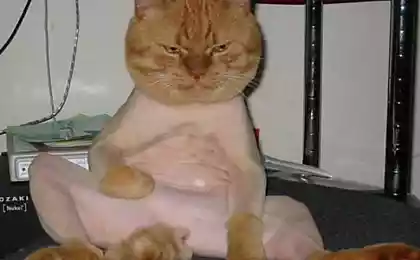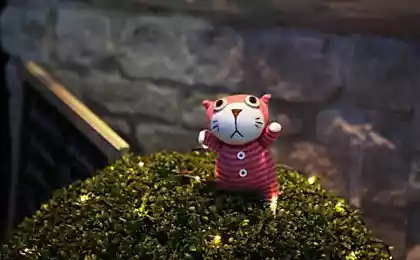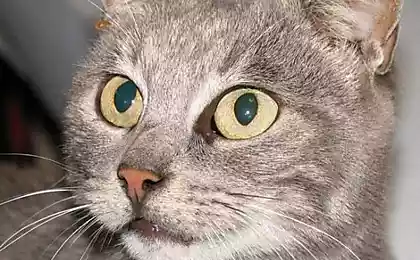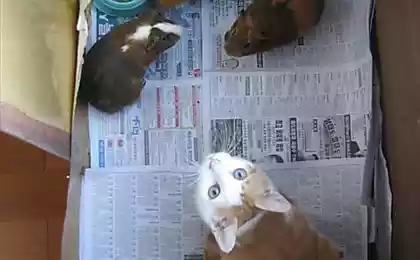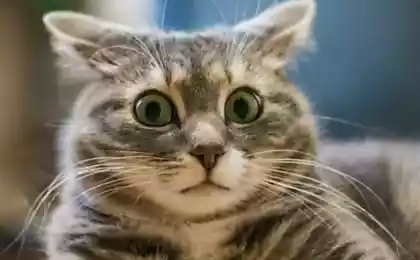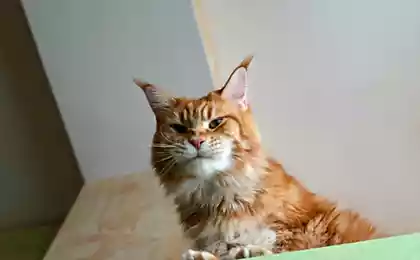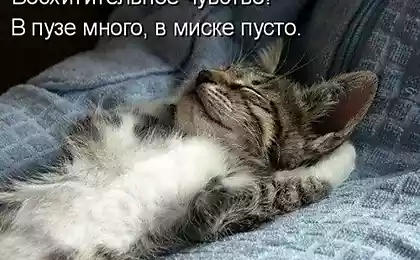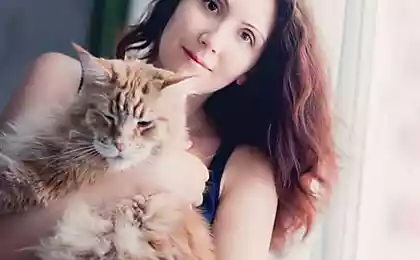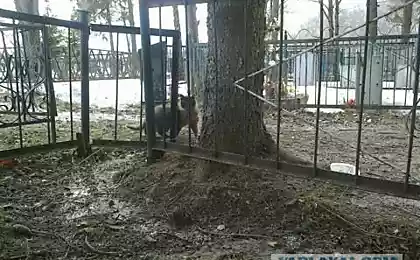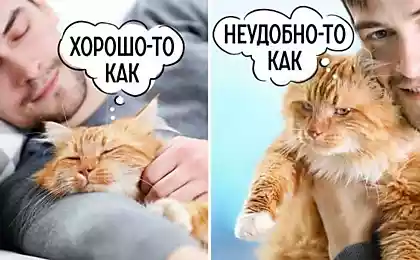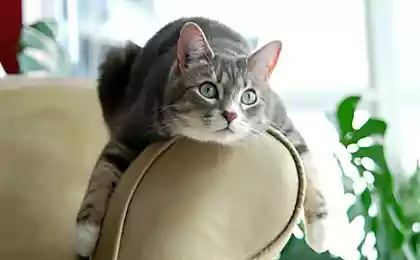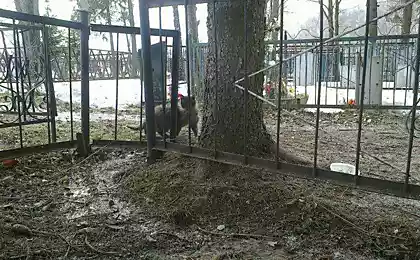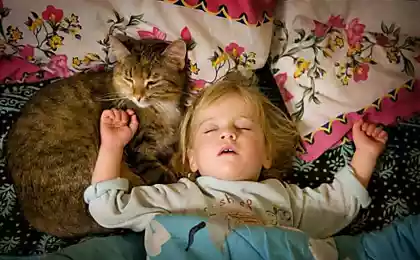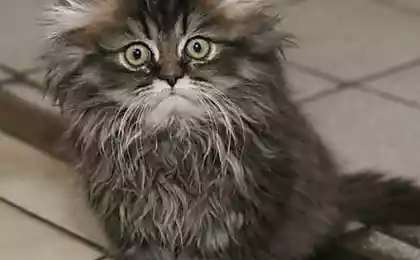1444
Meow exotica
We all love to brag svoii Fuzzy regardless of their breed, coat and color. But today I want to talk about rare species that usually were removed recently and those that there are a small number. Selkirk Rex
Most of the new breeds begins with the birth of one or two special kittens. As was the case a stray cat from Montana in 1987. Kish brought five kittens, one of which stood out thick and curly fur.
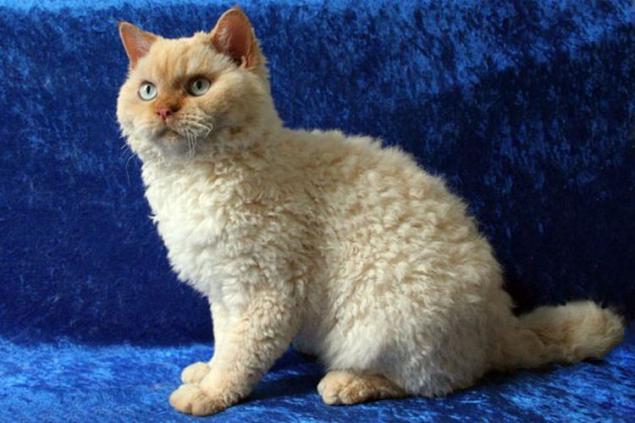
Kitten-Lamb was in the caring hands of a breeder of Persians. Breeder few years later brought a new breed, called selkirksky Rex. This is one of the youngest rocks. In the formation of the breed took part Persians, Exotic and British. Officially recognized only in 1992, it appeared in Russia in the late 1990s. Breed carries the gene curly hair. Cats are both longhair and shorthair.
Kittens longhaired Selkirk Rex born very curly. Then lose their curl and restore it only between the eighth and tenth month of life. Wool longhaired Selkirk Rex is quite unique, it combines all three types of hair, which is why long-haired Selkirk Rex looks very exotic.
This breed is called differently: pudelki, sheep, bear cubs. But their love to all who are familiar with them, regardless of the name. These funny funny cats do not leave anyone indifferent. Selkirk Rex are malleable peaceful character. Attached to people. Character Selkirk Rex reflects the characteristics of all breeds used in their creation.

Scottish Fold
In 1961 William Ross found the first known Scottish Fold kitten on a farm near Cupar Angus in the Tayside (Scotland), north-west of Dundee. Ross bought from the owner of a white kitten, who became the founder of a new breed. The uniqueness of the kitten was in the ears, cute bent forward and hanging down his head.
Appearance reminiscent of the bear (some sovёnka), made a strong impression on many American fans and judges. Scottish Fold has received the status of the exhibition Cat Fanciers' Association (CFA) in 1978. Many of the initial folds were not short, but just the opposite, long hair.
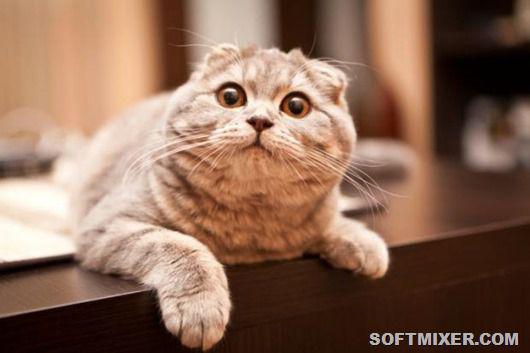
Scottish Fold
In 1961 William Ross found the first known Scottish Fold kitten on a farm near Cupar Angus in the Tayside (Scotland), north-west of Dundee. Ross bought from the owner of a white kitten, who became the founder of a new breed. The uniqueness of the kitten was in the ears, cute bent forward and hanging down his head.
Appearance reminiscent of the bear (some sovёnka), made a strong impression on many American fans and judges. Scottish Fold has received the status of the exhibition Cat Fanciers' Association (CFA) in 1978. Many of the initial folds were not short, but just the opposite, long hair.
The impossibility of the existence of the breed in homozygous form, and the probability of harmful effects of mutations persuaded leading British feline organizations to ban the breeding of this breed. Thanks to research by geneticists in the United States, and breeders who perform these stringent recommendations, the breed has a good health.
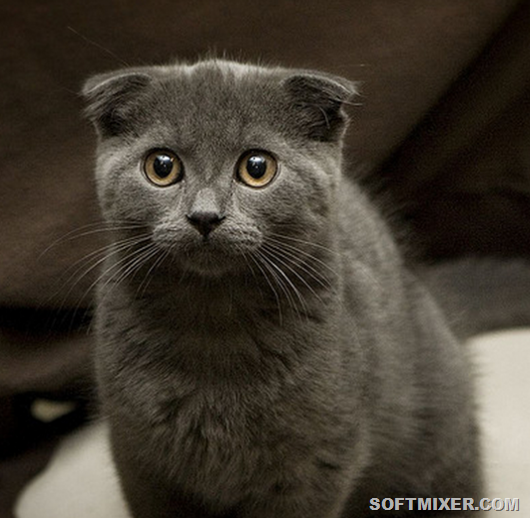
Ragamuffin cat
The word "ragamuffin cat" means "street bum." Among the ancestors of the eponymous breed of cats - they, wandering Murzik. And she ragamuffin cat breed, friendly room, there is a branch in the Ragdoll breeding in 1994.
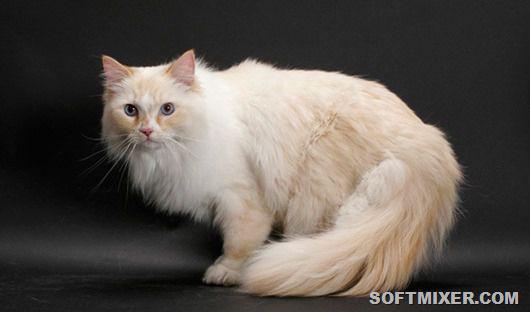
For mating with pedigree cats Ragdolls used with Persian, Himalayan, Siberian genes. Their faces were devoid of intrinsic same Persians detached arrogance, and the selection criterion was fluffy.
It turned out that fluffiness onaya erected in principle, stimulates this breed to be very kind to people that the last touches to tears. Certainly, genes are grateful for the good yard seals also played a role in the formation of the "white race" couch potatoes, ragamuffin cat, eliminating the need to hunt.
The nature of this breed calm, smart, playful, affectionate; easily adapt to life in all circumstances, like to be in the hands of the owners; do not resist any action of man; well trainable; coexist with any pets; I do not know how to defend themselves, just hiding, no hunting instincts. Recommended for all families.
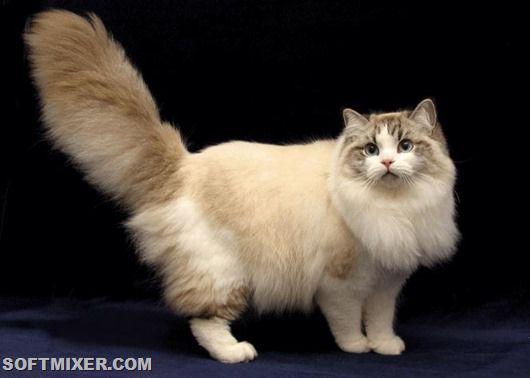
Sphynx
In 1986 in Rostov-on-Don certain academic lady saved from injury street kitten. While the chosen cat named Varvara was growing up, her back very shabby. When Barbara paired with the usual European Vaska, cub in the litter was balding with the same properties.
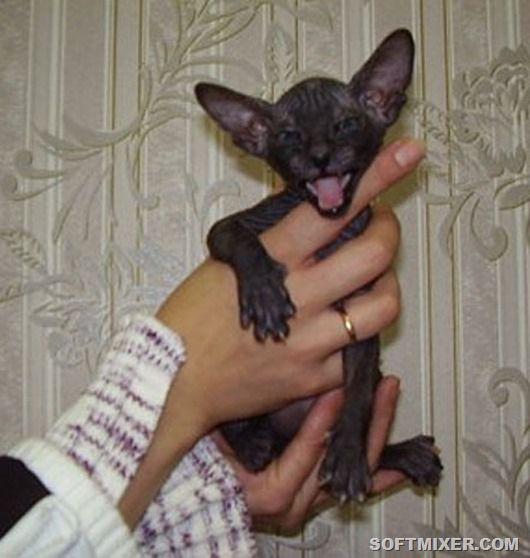
Its founder breed named Chita. After five years of hybridization appeared Russian folk rock "Sphynx", which has been recognized around the world in 1996. Loss of these cats - dominant genetic trait. Therefore, the mutation in the Sphinx of Russian Rostov secured more than their Canadian counterparts for baldness.
Cat thermophilic, so you need to keep it in a warm room. Street maintenance is possible or is highly undesirable. Due to the increased heat transfer sphynx consume slightly more food than other cat.
Cat non-conflict with the content with children and other animals. No characteristic odor, wool remains on things. People who are allergic to cat hair, the reaction to the presence of Don Sphynx observed less frequently. Many sphinxes are getting used to the same owner and retain the loyalty only to him.
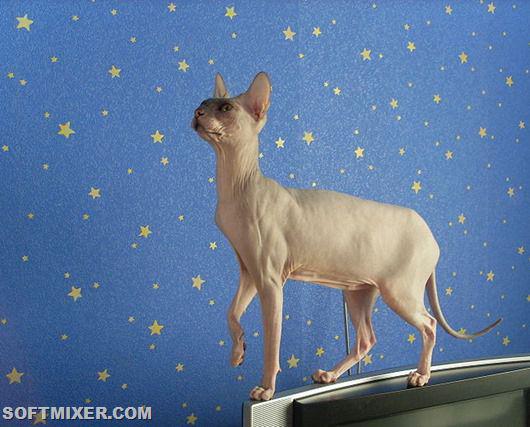
Minskin
Jokers fee once called "the cat that the dog dressed." A cat owner thinking, figured paws tails, and brought "cat dachshund". Breed minskin comes from short-legged Munchkin variety of seals and eared hairless Sphynx. Crossing two extreme varieties of cat breeders got a mini-rock sweetly horrific kind.
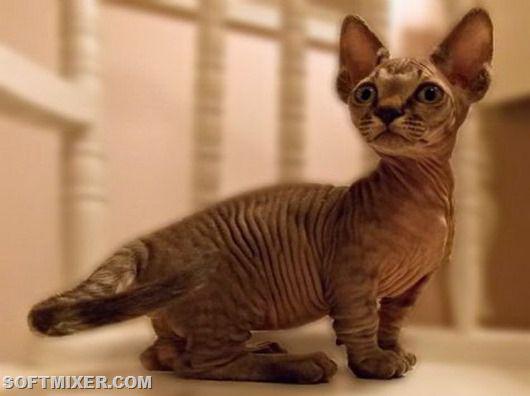
Despite his alien exterior, minskin very affectionate to owners and mobile. Unlike the sphinxes, these cats have a little bit about cashmere that iron is extremely exciting and probably good for your health, if you are not allergic to the aliens.
Representatives of different breeds minskin vivacity and charm, they are strikingly curious, courageous independent entity. Dogs and cats minskin very attached to their owners, they are easier to take with you on a business trip or vacation, rather than doomed to loneliness in your absence.
In addition, they quickly adapt to the new environment, thrive in transport and the new place is not so curious to create the problem or the owner himself. As a reward for the efforts you will be rewarded manifestations of tenderness, affection and love.
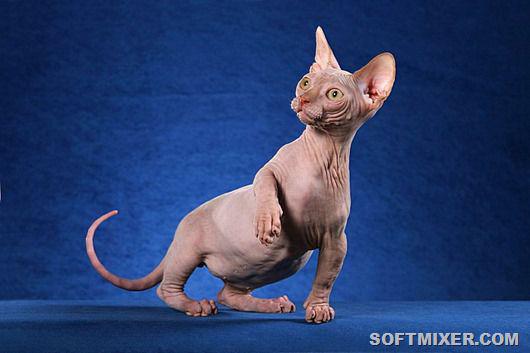
Ojos Azules
Ojos Azules - in Spanish means "blue eyes". The first representative of this breed, the designated color of eyes, was seen in the US New Mexico in 1984. Important in Ojos azules - the color of the cat's eyes, the rest of the role played by just the length of wool.
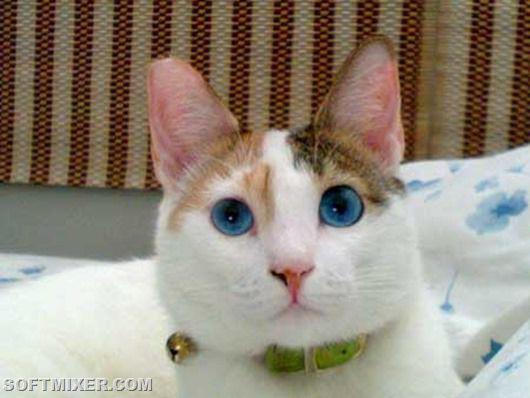
It is believed that all blue-eyed cats Mexican rock - one mom, ie breeding began with a kind of blue-eyed cat litter, hanging out with different serf cats. When the kittens grew up and gave a pretty offspring, it turned out that the blue eyes - it is a mysterious genetic trait is transmitted across the brood.
From this mutation, it turned into a rock, took - just know Our Lady of Guadalupe. Gene blue eye color gene was stronger, so the blue-eyed Kitties of New Mexico come in all colors.
Ojos azules excellent companions and family pets. They are very balanced, not prone to aggression, friendly and cute creatures. Animals of this breed have a high intelligence, and considerable patience. They feel good, both in the apartment and a private home.
Cats Ojos azules easy to get along with other household occupants, not conflict, often make friends with them. They are playful and not averse to entertain the kids. Cats of this breed is gentle and affectionate, quick snap to master, suffer alone and unattended. And they are well accustomed to the new environment.
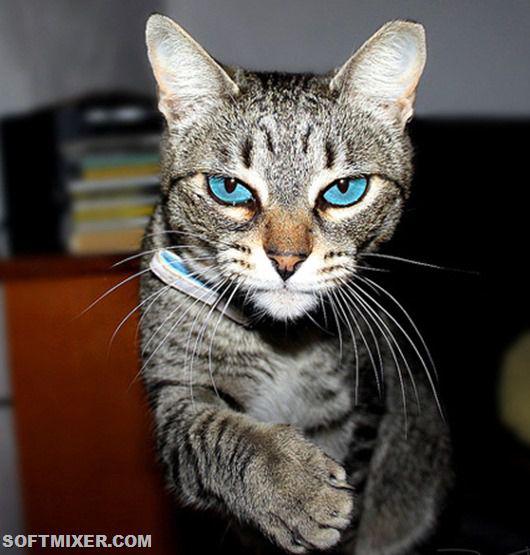
Burmilla
In the history of Burma has never been a calm moment, so cats that come from a perceived hereditary refugee women, paying-faced for the good and the good of the mug.
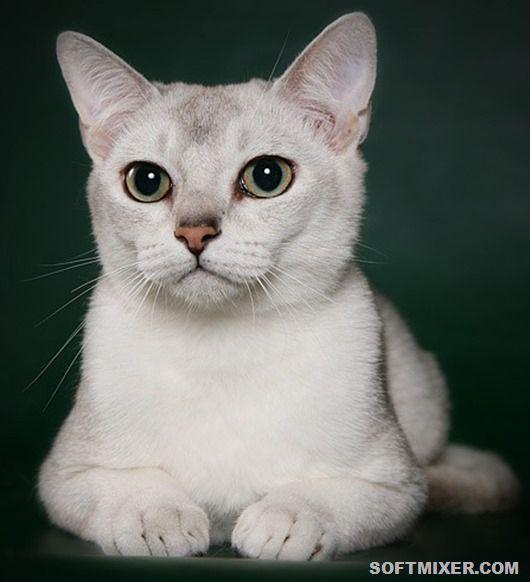
Burmilla breed was born by accident in the house of a rich lady in 1981. Once Madame did not watch as the Persian chinchilla cat loved Burmese cat breed. As a result, interest kittens, it was decided to make fathers and mothers of a new species of pet lion. In 1994, the Burmilla was officially recognized in the higher circles of the supreme kotozavodchikov.
Character Burmilla incorporates all the best features of: affectionate, gentle, friendly, intelligent. This breed is moderately playful and rather quiet. Many who have this cat at home, or met with her life, saying "the dog in the cat's body" because dogs are the same faithful.
It is believed that from the Persian cat, she inherited a calm peaceful nature, but from the Burmese wisdom and intelligence. The only thing that can not tolerate Burmilla - is loneliness, which is often as death for her. Burmilla loves to "talk" on the need to deal with it as often as possible.
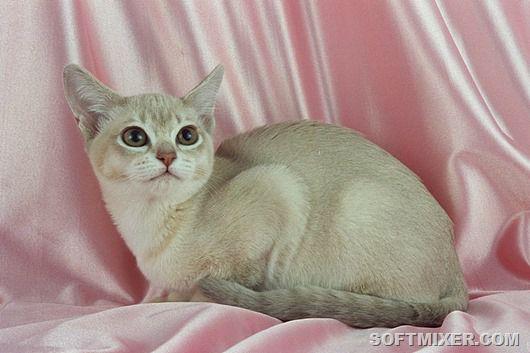
Sokoke
His thoroughbred named this cat owes historic homeland - forest reserve Arabuko-Sokoke, located in Kenya. According to the adopted version, Sokoke - a product of the late domestication of wild cats Kenyan savannah certain ekstrerera and temperament.
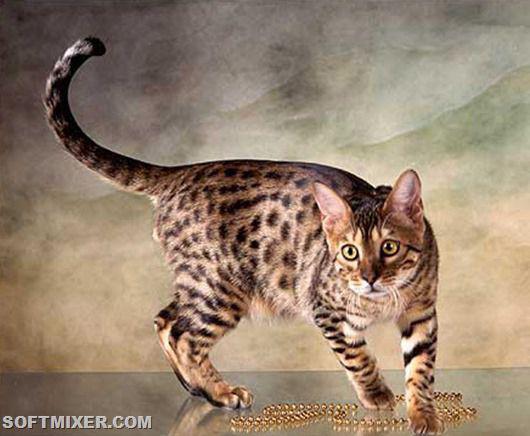
The first Sokoke were presented as domestic cats in 1978. This was the result of a random rotation of international friendship - a resident of Kenya gave two semi-wild kittens a specialist from Denmark, which was friendly. As a result, the breed came into being long-legged, slender cats of African descent.
In 1992 Sokoke was officially recognized in Denmark, and then found out about it the whole world. The International Federation of cat lovers have recognized this breed in 1993.
The nature of such an independent and cats at the same time they are very attached to their owners. They are very active and playful, and they are very curious and affectionate. It is easy to get along with other pets and dogs in particular. Absolutely not to be afraid of water treatments.
But despite the fact that these cats in general very easily domesticated and live happily in apartments yet they are in need of walks where you can frolic heartily and have a good stretch your legs.
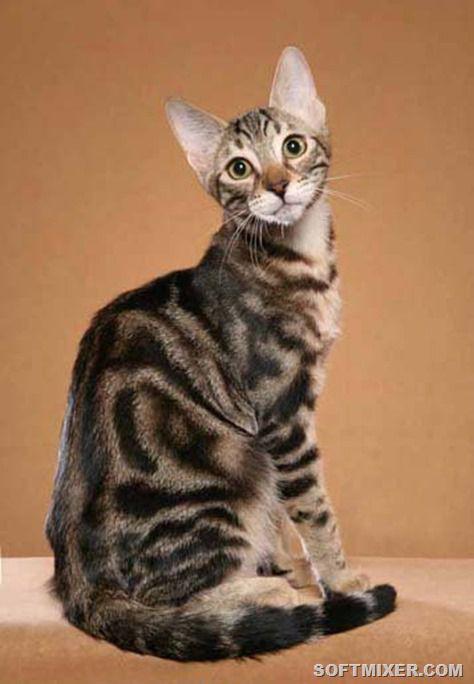
Napoleon
Napoleon? Yes indeed. You read that right ... There is a breed of cat, named in honor of the great commander, French Emperor Napoleon Bonaparte - a man of very small stature and panic boyavshegosya cats. Therefore unlikely he was delighted when he knew that modern breeders decided to immortalize his name in the title of the new breed.
Interestingly, this is not the imperial breed brought felinologist and dog lover, devoted to the breeding Basset. June 12, 1995 the American breeder Joe Smith read in the «Wall Street Journal» article on crumbs breed munchkin and was fascinated by these short-legged purring.
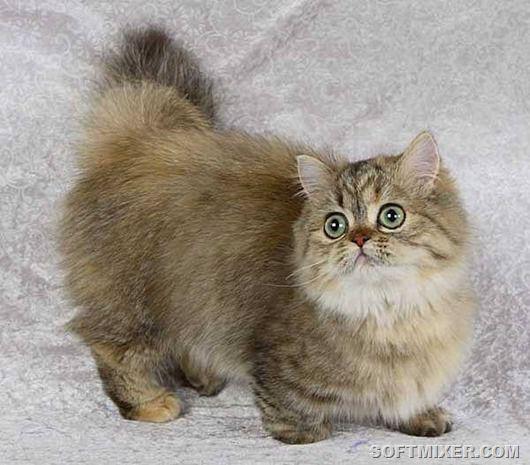
With Smith got the idea on the basis of munchkins create a cat-litter of great beauty, the main feature of which are tiny and touching muzzle. And the length of the legs had no special significance, since in a single breed Smith decided to plant two kinds of cats - with short and long legs are equally sought after and valuable. Thus was born Napoleon-classic with the usual length of the legs and korotkopalye Napoleon-extreme (for fans of the exotic).
Smith put his idea to a lot of effort, money and time to his child has acquired a worldwide love and recognition. At one point he so desperate that castrated, sold and distributed available to him Napoleon. And even destroyed all the information on their breeding.
However, cats were so adorable that it inspired other breeders Smith. Napoleon and the breed was accepted for registration in the TICA (USA) and ASSOLYUKS (Russia).
A smart, sociable, affectionate and very trusting breed. They do not understand that such aggression, so children can swaddle the little emperor as a doll in a stroller to carry. It allows all! If you take napoleonchika up, he obmyaknet as cloth, his whole appearance saying, "Do with me whatever you wish - only love!».
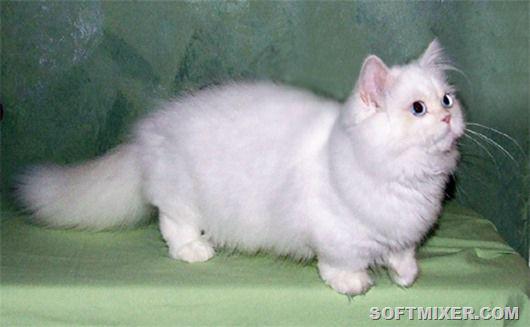
Toyger
If everything in life has become boring, you can find yourself not even a cat and a whole tiger. Not really a toy, but a little - on the feeding of which do not have to go broke.
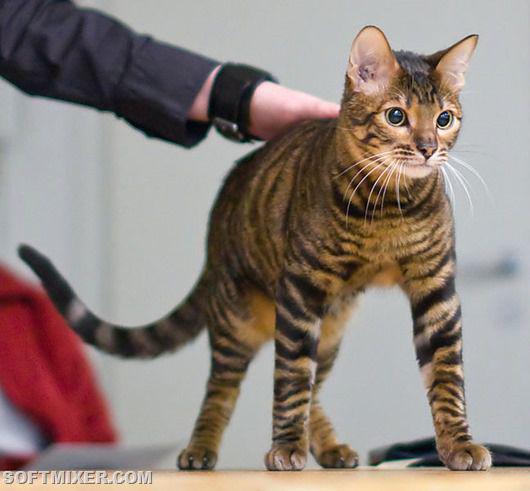
Breed "Toyger" order was created to their banding these seals reminded their hosts hosts the Asian jungles. Well, or mackerel.
Toyger first told his meow in the late 1980s in America, and are so-called "designer" cats. The author of the breed is Judy Sugden. In Russia the first cats were brought in 2008. Toyger breed got its name from the English words: toy (toy) + tiger (tiger) = toyger (toy tiger), ie Toyger.
The breed is still developing, and its defect is the presence of domestic animals "Tiger" temperament. That is, the standard Toyger have to be gentle, down to shyness. This is a very clever animal. They do not require a lot of attention from the owner, but exhibit very real devotion. Kittens of this breed are very expensive.
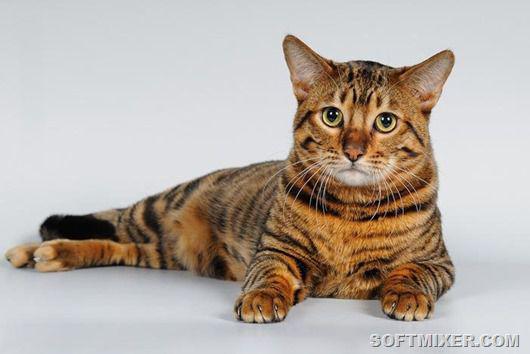
Source: www.softmixer.com
Most of the new breeds begins with the birth of one or two special kittens. As was the case a stray cat from Montana in 1987. Kish brought five kittens, one of which stood out thick and curly fur.

Kitten-Lamb was in the caring hands of a breeder of Persians. Breeder few years later brought a new breed, called selkirksky Rex. This is one of the youngest rocks. In the formation of the breed took part Persians, Exotic and British. Officially recognized only in 1992, it appeared in Russia in the late 1990s. Breed carries the gene curly hair. Cats are both longhair and shorthair.
Kittens longhaired Selkirk Rex born very curly. Then lose their curl and restore it only between the eighth and tenth month of life. Wool longhaired Selkirk Rex is quite unique, it combines all three types of hair, which is why long-haired Selkirk Rex looks very exotic.
This breed is called differently: pudelki, sheep, bear cubs. But their love to all who are familiar with them, regardless of the name. These funny funny cats do not leave anyone indifferent. Selkirk Rex are malleable peaceful character. Attached to people. Character Selkirk Rex reflects the characteristics of all breeds used in their creation.

Scottish Fold
In 1961 William Ross found the first known Scottish Fold kitten on a farm near Cupar Angus in the Tayside (Scotland), north-west of Dundee. Ross bought from the owner of a white kitten, who became the founder of a new breed. The uniqueness of the kitten was in the ears, cute bent forward and hanging down his head.
Appearance reminiscent of the bear (some sovёnka), made a strong impression on many American fans and judges. Scottish Fold has received the status of the exhibition Cat Fanciers' Association (CFA) in 1978. Many of the initial folds were not short, but just the opposite, long hair.

Scottish Fold
In 1961 William Ross found the first known Scottish Fold kitten on a farm near Cupar Angus in the Tayside (Scotland), north-west of Dundee. Ross bought from the owner of a white kitten, who became the founder of a new breed. The uniqueness of the kitten was in the ears, cute bent forward and hanging down his head.
Appearance reminiscent of the bear (some sovёnka), made a strong impression on many American fans and judges. Scottish Fold has received the status of the exhibition Cat Fanciers' Association (CFA) in 1978. Many of the initial folds were not short, but just the opposite, long hair.
The impossibility of the existence of the breed in homozygous form, and the probability of harmful effects of mutations persuaded leading British feline organizations to ban the breeding of this breed. Thanks to research by geneticists in the United States, and breeders who perform these stringent recommendations, the breed has a good health.

Ragamuffin cat
The word "ragamuffin cat" means "street bum." Among the ancestors of the eponymous breed of cats - they, wandering Murzik. And she ragamuffin cat breed, friendly room, there is a branch in the Ragdoll breeding in 1994.

For mating with pedigree cats Ragdolls used with Persian, Himalayan, Siberian genes. Their faces were devoid of intrinsic same Persians detached arrogance, and the selection criterion was fluffy.
It turned out that fluffiness onaya erected in principle, stimulates this breed to be very kind to people that the last touches to tears. Certainly, genes are grateful for the good yard seals also played a role in the formation of the "white race" couch potatoes, ragamuffin cat, eliminating the need to hunt.
The nature of this breed calm, smart, playful, affectionate; easily adapt to life in all circumstances, like to be in the hands of the owners; do not resist any action of man; well trainable; coexist with any pets; I do not know how to defend themselves, just hiding, no hunting instincts. Recommended for all families.

Sphynx
In 1986 in Rostov-on-Don certain academic lady saved from injury street kitten. While the chosen cat named Varvara was growing up, her back very shabby. When Barbara paired with the usual European Vaska, cub in the litter was balding with the same properties.

Its founder breed named Chita. After five years of hybridization appeared Russian folk rock "Sphynx", which has been recognized around the world in 1996. Loss of these cats - dominant genetic trait. Therefore, the mutation in the Sphinx of Russian Rostov secured more than their Canadian counterparts for baldness.
Cat thermophilic, so you need to keep it in a warm room. Street maintenance is possible or is highly undesirable. Due to the increased heat transfer sphynx consume slightly more food than other cat.
Cat non-conflict with the content with children and other animals. No characteristic odor, wool remains on things. People who are allergic to cat hair, the reaction to the presence of Don Sphynx observed less frequently. Many sphinxes are getting used to the same owner and retain the loyalty only to him.

Minskin
Jokers fee once called "the cat that the dog dressed." A cat owner thinking, figured paws tails, and brought "cat dachshund". Breed minskin comes from short-legged Munchkin variety of seals and eared hairless Sphynx. Crossing two extreme varieties of cat breeders got a mini-rock sweetly horrific kind.

Despite his alien exterior, minskin very affectionate to owners and mobile. Unlike the sphinxes, these cats have a little bit about cashmere that iron is extremely exciting and probably good for your health, if you are not allergic to the aliens.
Representatives of different breeds minskin vivacity and charm, they are strikingly curious, courageous independent entity. Dogs and cats minskin very attached to their owners, they are easier to take with you on a business trip or vacation, rather than doomed to loneliness in your absence.
In addition, they quickly adapt to the new environment, thrive in transport and the new place is not so curious to create the problem or the owner himself. As a reward for the efforts you will be rewarded manifestations of tenderness, affection and love.

Ojos Azules
Ojos Azules - in Spanish means "blue eyes". The first representative of this breed, the designated color of eyes, was seen in the US New Mexico in 1984. Important in Ojos azules - the color of the cat's eyes, the rest of the role played by just the length of wool.

It is believed that all blue-eyed cats Mexican rock - one mom, ie breeding began with a kind of blue-eyed cat litter, hanging out with different serf cats. When the kittens grew up and gave a pretty offspring, it turned out that the blue eyes - it is a mysterious genetic trait is transmitted across the brood.
From this mutation, it turned into a rock, took - just know Our Lady of Guadalupe. Gene blue eye color gene was stronger, so the blue-eyed Kitties of New Mexico come in all colors.
Ojos azules excellent companions and family pets. They are very balanced, not prone to aggression, friendly and cute creatures. Animals of this breed have a high intelligence, and considerable patience. They feel good, both in the apartment and a private home.
Cats Ojos azules easy to get along with other household occupants, not conflict, often make friends with them. They are playful and not averse to entertain the kids. Cats of this breed is gentle and affectionate, quick snap to master, suffer alone and unattended. And they are well accustomed to the new environment.

Burmilla
In the history of Burma has never been a calm moment, so cats that come from a perceived hereditary refugee women, paying-faced for the good and the good of the mug.

Burmilla breed was born by accident in the house of a rich lady in 1981. Once Madame did not watch as the Persian chinchilla cat loved Burmese cat breed. As a result, interest kittens, it was decided to make fathers and mothers of a new species of pet lion. In 1994, the Burmilla was officially recognized in the higher circles of the supreme kotozavodchikov.
Character Burmilla incorporates all the best features of: affectionate, gentle, friendly, intelligent. This breed is moderately playful and rather quiet. Many who have this cat at home, or met with her life, saying "the dog in the cat's body" because dogs are the same faithful.
It is believed that from the Persian cat, she inherited a calm peaceful nature, but from the Burmese wisdom and intelligence. The only thing that can not tolerate Burmilla - is loneliness, which is often as death for her. Burmilla loves to "talk" on the need to deal with it as often as possible.

Sokoke
His thoroughbred named this cat owes historic homeland - forest reserve Arabuko-Sokoke, located in Kenya. According to the adopted version, Sokoke - a product of the late domestication of wild cats Kenyan savannah certain ekstrerera and temperament.

The first Sokoke were presented as domestic cats in 1978. This was the result of a random rotation of international friendship - a resident of Kenya gave two semi-wild kittens a specialist from Denmark, which was friendly. As a result, the breed came into being long-legged, slender cats of African descent.
In 1992 Sokoke was officially recognized in Denmark, and then found out about it the whole world. The International Federation of cat lovers have recognized this breed in 1993.
The nature of such an independent and cats at the same time they are very attached to their owners. They are very active and playful, and they are very curious and affectionate. It is easy to get along with other pets and dogs in particular. Absolutely not to be afraid of water treatments.
But despite the fact that these cats in general very easily domesticated and live happily in apartments yet they are in need of walks where you can frolic heartily and have a good stretch your legs.

Napoleon
Napoleon? Yes indeed. You read that right ... There is a breed of cat, named in honor of the great commander, French Emperor Napoleon Bonaparte - a man of very small stature and panic boyavshegosya cats. Therefore unlikely he was delighted when he knew that modern breeders decided to immortalize his name in the title of the new breed.
Interestingly, this is not the imperial breed brought felinologist and dog lover, devoted to the breeding Basset. June 12, 1995 the American breeder Joe Smith read in the «Wall Street Journal» article on crumbs breed munchkin and was fascinated by these short-legged purring.

With Smith got the idea on the basis of munchkins create a cat-litter of great beauty, the main feature of which are tiny and touching muzzle. And the length of the legs had no special significance, since in a single breed Smith decided to plant two kinds of cats - with short and long legs are equally sought after and valuable. Thus was born Napoleon-classic with the usual length of the legs and korotkopalye Napoleon-extreme (for fans of the exotic).
Smith put his idea to a lot of effort, money and time to his child has acquired a worldwide love and recognition. At one point he so desperate that castrated, sold and distributed available to him Napoleon. And even destroyed all the information on their breeding.
However, cats were so adorable that it inspired other breeders Smith. Napoleon and the breed was accepted for registration in the TICA (USA) and ASSOLYUKS (Russia).
A smart, sociable, affectionate and very trusting breed. They do not understand that such aggression, so children can swaddle the little emperor as a doll in a stroller to carry. It allows all! If you take napoleonchika up, he obmyaknet as cloth, his whole appearance saying, "Do with me whatever you wish - only love!».

Toyger
If everything in life has become boring, you can find yourself not even a cat and a whole tiger. Not really a toy, but a little - on the feeding of which do not have to go broke.

Breed "Toyger" order was created to their banding these seals reminded their hosts hosts the Asian jungles. Well, or mackerel.
Toyger first told his meow in the late 1980s in America, and are so-called "designer" cats. The author of the breed is Judy Sugden. In Russia the first cats were brought in 2008. Toyger breed got its name from the English words: toy (toy) + tiger (tiger) = toyger (toy tiger), ie Toyger.
The breed is still developing, and its defect is the presence of domestic animals "Tiger" temperament. That is, the standard Toyger have to be gentle, down to shyness. This is a very clever animal. They do not require a lot of attention from the owner, but exhibit very real devotion. Kittens of this breed are very expensive.

Source: www.softmixer.com

